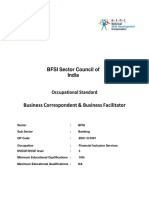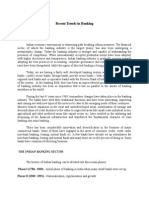Assignment Rathnayake
Assignment Rathnayake
Uploaded by
Prasanna WickramasekaraCopyright:
Available Formats
Assignment Rathnayake
Assignment Rathnayake
Uploaded by
Prasanna WickramasekaraCopyright
Available Formats
Share this document
Did you find this document useful?
Is this content inappropriate?
Copyright:
Available Formats
Assignment Rathnayake
Assignment Rathnayake
Uploaded by
Prasanna WickramasekaraCopyright:
Available Formats
Business Mathematics and Statistics
Statistical Analysis of Money, Banking and Finance Sector in Sri Lanka
Introduction
The financial sector in Sri Lanka, reflect a broad range of reforms introduced since1977 that includes most of the institutional elements of a modern financial system. The two state owned commercial banks namely Bank of Ceylon & Peoples Bank dominate the market in terms of assets. However there is a wide range of other institutions offering similar financial services. In addition to these financial intermediaries, market intermediation has been developed with the capitalisation of the Colombo Stock Exchange (CSE). The banks are active in virtually all aspects of financial services; with most having subsidiaries or affiliates engaged in insurance and capital markets activities. The key to financial sector development in Sri Lanka is continuation with the broad thrust of reforms begun in 1977s to strengthen the government infrastructure and institutional framework, while decreasing direct government intervention. Significant progress has been made, and considerable technical assistance has been provided by the international community on this direction. The quality of banking supervision has been improved remarkably with all banks now being examined on-site at least once in 2 year cycle. Together with increased depth in off-site analysis, this has greatly improved the ability of the Central Bank of Sri Lanka to identify weaknesses in banks, although the implementation of remedial measures seems still lacks decisiveness and effectiveness. Sustainable progress is dependent on further improvements in the legal framework for financial services and commercial transactions more generally, building infrastructure, and strengthening and
enforcing prudential norms. Equally important is the reform of the state owned institutions which consume resources through their own inefficiency and also provide an umbrella to shield other institutions from full competition, contributing to the high cost of credit. Prudential standards have been strengthened. Capitalisation of the banking sector has actually been improved because of prudential standards extended to include foreign banking units (FBUs) that account for 20 to 25% of banking sector assets, and loan loss provisioning, while still inadequate, has been improved. Further, the high cost of credit remains a significant policy concern as this hamper economic development in all dimensions. The spread between deposit and lending rates has been widened as interest rates have declined over the last couple of years. However, the improved margins are essential for the weaker banks to earn enough to cover their accumulated loan losses and high operating expenses. Sri Lankan individuals and businesses have not been benefited from the operational cost savings and efficiency gains arising from the electronic payment system. The state-owned banks such as Peoples Bank, Bank of Ceylon and National Savings Bank having the largest branch networks and numbers of deposit accounts are not fully computerized and networked. Furthermore the competition that was created by opening up the economy for private sector was a huge challenge for hither to leading public sector financial institutes. The customers who previously did not have an alternative but to be satisfied with the bureaucratic approach of public sector banks now got an opportunity to enjoy service quality of private sector service providers that resulted due to healthy competition. As such customers now enjoy benefit of competitive lending rates offered by service providers in order to grab business.
You might also like
- Module - Business Correspondent and FacilitatorDocument80 pagesModule - Business Correspondent and FacilitatorVaibhavNo ratings yet
- Outline (LONG) Real Estate Trans. (Dewey, 2017 Spring)Document52 pagesOutline (LONG) Real Estate Trans. (Dewey, 2017 Spring)Larry Rogers100% (1)
- Credit Management PolicyDocument83 pagesCredit Management PolicyVallabh Utpat100% (1)
- Service MarketingDocument10 pagesService MarketingsamadhinethmaNo ratings yet
- Asset Quality As A Determinant of Commercial Banks Financial Performance in KenyaDocument12 pagesAsset Quality As A Determinant of Commercial Banks Financial Performance in KenyaAsegid GetachewNo ratings yet
- Perspectives On The Indian Banking Sector: Q: Are The Indian Banks Geared Up For Transition To The InternationalDocument5 pagesPerspectives On The Indian Banking Sector: Q: Are The Indian Banks Geared Up For Transition To The InternationalAbhay AgarwalNo ratings yet
- Challenges Facing Implimentation of CRB Regulations in Kenya Commercial Banks in Kakamega TownshipDocument10 pagesChallenges Facing Implimentation of CRB Regulations in Kenya Commercial Banks in Kakamega TownshipAlexander DeckerNo ratings yet
- Indian Banking SectorDocument5 pagesIndian Banking Sector2612010No ratings yet
- 58852Document8 pages58852santoshimedisetti890No ratings yet
- Recent Trends in BankingDocument8 pagesRecent Trends in BankingAdalberto MacdonaldNo ratings yet
- Banking Sector Reforms in Bangladesh: Measures and Economic OutcomesDocument25 pagesBanking Sector Reforms in Bangladesh: Measures and Economic OutcomesFakhrul Islam RubelNo ratings yet
- Banking Sector ReformsDocument10 pagesBanking Sector ReformsTouqeer AhmadNo ratings yet
- Presentation 1Document11 pagesPresentation 1Vineet RanjanNo ratings yet
- Financial Sector Needs To Be FutureDocument6 pagesFinancial Sector Needs To Be FutureThavam RatnaNo ratings yet
- Banking Challenges 09AC31 PsgimDocument10 pagesBanking Challenges 09AC31 Psgimscribd09ac31No ratings yet
- Recent Trends in BankingDocument8 pagesRecent Trends in BankingNeha bansalNo ratings yet
- Welcome To My PresentationDocument12 pagesWelcome To My PresentationArafatNo ratings yet
- Fmi Assignment IIDocument14 pagesFmi Assignment IItitiksha jewrajkaNo ratings yet
- Drivers of Change in Banking IndustriesDocument3 pagesDrivers of Change in Banking IndustriesPatrick Njuguna100% (1)
- CERTIFICATEDocument31 pagesCERTIFICATEShanawaz ArifNo ratings yet
- Evolution of Indian Financial SystemDocument2 pagesEvolution of Indian Financial SystemvivekNo ratings yet
- Industry AnalysisDocument16 pagesIndustry Analysisamisha kapriNo ratings yet
- 02 IntroductionDocument3 pages02 Introductionmukherjeeprity52No ratings yet
- Prime Banks Credit CardDocument9 pagesPrime Banks Credit CardIsmat Jerin ChetonaNo ratings yet
- Non-Performing Assets and Twin Balance Sheet ProblemDocument6 pagesNon-Performing Assets and Twin Balance Sheet ProblemAmlan MishraNo ratings yet
- Banking Sector Reforms and Customer Satisfaction in Pakistan 15Document15 pagesBanking Sector Reforms and Customer Satisfaction in Pakistan 15mubashirfscNo ratings yet
- Executive - AnswersDocument53 pagesExecutive - AnswersRakesh KushwahaNo ratings yet
- The Structure of Financial System of BangladeshDocument8 pagesThe Structure of Financial System of Bangladeshmoaz_tareq1622No ratings yet
- Task 11: Banking Industry Analysis Based On Current SituationDocument10 pagesTask 11: Banking Industry Analysis Based On Current Situationsnithisha chandranNo ratings yet
- Factors Affecting Deposit MobilizationDocument13 pagesFactors Affecting Deposit MobilizationVu Minh ChauNo ratings yet
- Competition, Consolidation and Systemic Stability in The Indian Banking IndustryDocument5 pagesCompetition, Consolidation and Systemic Stability in The Indian Banking IndustryBharat A. VashisthaNo ratings yet
- The Banking Industry Has Been Experiencing Major Mergers and Acquisitions in Recent YearsDocument3 pagesThe Banking Industry Has Been Experiencing Major Mergers and Acquisitions in Recent Yearsaditya bNo ratings yet
- Commercial Banks and Industrial Finance - Evolving Role: Prof. Neelam TandonDocument26 pagesCommercial Banks and Industrial Finance - Evolving Role: Prof. Neelam TandonAtisha JunejaNo ratings yet
- Barclay BankDocument6 pagesBarclay BankAshar Sultan KayaniNo ratings yet
- Initiating Coverage On UBI LTDDocument16 pagesInitiating Coverage On UBI LTDpriyankachibchibNo ratings yet
- Lecture 1.5 Recent Development in BankingDocument6 pagesLecture 1.5 Recent Development in BankingCharu Saxena16No ratings yet
- A STUDY ON LOAN MANAGEMENT OF NEPAL BANK LIMITED AND AGRICULTURAL DEVELOPMENT BANK LIMITED1stDocument7 pagesA STUDY ON LOAN MANAGEMENT OF NEPAL BANK LIMITED AND AGRICULTURAL DEVELOPMENT BANK LIMITED1stOmisha KhatiwadaNo ratings yet
- 5.1 Role of Commercial BanksDocument5 pages5.1 Role of Commercial Banksbabunaidu2006No ratings yet
- Neplese Banking IndustryDocument7 pagesNeplese Banking IndustryRajesh ShresthaNo ratings yet
- Banking Sector Reforms 23 Dec 06Document9 pagesBanking Sector Reforms 23 Dec 06shoaibmbaNo ratings yet
- Contemporary Issues in Banking Sector in BangladeshDocument8 pagesContemporary Issues in Banking Sector in Bangladeshangel100% (6)
- "Marketing Ofbaroda Cash Management Services by Neelam NiveditaDocument60 pages"Marketing Ofbaroda Cash Management Services by Neelam NiveditaAakash JadiyaNo ratings yet
- Examining The Impact of Loan Diversification Policy On The Operational Efficiency of Bank of Kigali and Ecobank RwandaDocument26 pagesExamining The Impact of Loan Diversification Policy On The Operational Efficiency of Bank of Kigali and Ecobank RwandaKIU PUBLICATION AND EXTENSIONNo ratings yet
- Chapter 7Document7 pagesChapter 7Wholesome BlogsNo ratings yet
- Recent Trends in Banking: Source: E-Mail Dt. 7 June 2012Document9 pagesRecent Trends in Banking: Source: E-Mail Dt. 7 June 2012NikitaNo ratings yet
- Yes BankDocument30 pagesYes BankVivek PrakashNo ratings yet
- KCB Term PaperDocument7 pagesKCB Term Papermainasheilawanjiku2003No ratings yet
- Classens, K. and Van Horen, N. (2012) Foreign Banks: Trends, Impact and Financial Stability', IMF Working Paper, International Monetary FundDocument4 pagesClassens, K. and Van Horen, N. (2012) Foreign Banks: Trends, Impact and Financial Stability', IMF Working Paper, International Monetary FundMinh VănNo ratings yet
- Direct Impact of Covid-19 On Indian Banking SystemDocument3 pagesDirect Impact of Covid-19 On Indian Banking SystemPuneet Singh DhaniNo ratings yet
- Meezan BankDocument10 pagesMeezan BankAsad Ali MinhasNo ratings yet
- Project Report "Banking System" in India Introduction of BankingDocument9 pagesProject Report "Banking System" in India Introduction of BankingmanishteensNo ratings yet
- Internship Report Deposit Mobilization of NCC BankDocument74 pagesInternship Report Deposit Mobilization of NCC BankSauron88850% (2)
- Case Study HBLDocument16 pagesCase Study HBLdeadman710% (1)
- ST MGT FinalDocument20 pagesST MGT Finallocalfreelance1134No ratings yet
- Project Report "Banking System" in India Introduction of BankingDocument27 pagesProject Report "Banking System" in India Introduction of BankingShruti GargNo ratings yet
- Presented by Group 18: Neha Srivastava Sneha Shivam Garg TarunaDocument41 pagesPresented by Group 18: Neha Srivastava Sneha Shivam Garg TarunaNeha SrivastavaNo ratings yet
- Finance Project On Various Credit Schemes of SBIDocument46 pagesFinance Project On Various Credit Schemes of SBItaanvi00783% (6)
- Project On Various Credit Schemes of SBI Back PDFDocument46 pagesProject On Various Credit Schemes of SBI Back PDFAbhinaw KumarNo ratings yet
- IBE Budget PoliciesDocument9 pagesIBE Budget PoliciesKanishq BawejaNo ratings yet
- T R A N S F O R M A T I O N: THREE DECADES OF INDIA’S FINANCIAL AND BANKING SECTOR REFORMS (1991–2021)From EverandT R A N S F O R M A T I O N: THREE DECADES OF INDIA’S FINANCIAL AND BANKING SECTOR REFORMS (1991–2021)No ratings yet
- 1 Robinsonian Building Loan Interest Tables 1909 J.watts RobinsonDocument224 pages1 Robinsonian Building Loan Interest Tables 1909 J.watts Robinsonmartin160464No ratings yet
- Moneyview DisplayDocument2 pagesMoneyview Displaypiyushgawariya143No ratings yet
- Introduction To Advanced Financial ManagementDocument33 pagesIntroduction To Advanced Financial ManagementShubashPoojariNo ratings yet
- 2020 T3 GSBS6410 Lecture Note For Week 11 Adverse Selection NewDocument35 pages2020 T3 GSBS6410 Lecture Note For Week 11 Adverse Selection NewRenu JhaNo ratings yet
- Loan Application Form Please Complete in BLOCK LETTERS.: Office UseDocument4 pagesLoan Application Form Please Complete in BLOCK LETTERS.: Office UseKennedy SimumbaNo ratings yet
- Case 3 3 Marketing PyramidDocument3 pagesCase 3 3 Marketing PyramidPeishi OngNo ratings yet
- Yawar Gulzar 20MCMS017116 (2ND)Document12 pagesYawar Gulzar 20MCMS017116 (2ND)Kalyan Gowda.SNo ratings yet
- Affidavit of General Financial ConditionDocument7 pagesAffidavit of General Financial ConditionyonportesNo ratings yet
- Assignment Difference EquationDocument4 pagesAssignment Difference EquationSriharshitha DeepalaNo ratings yet
- BONY FannieMasterCustodialAgreementDocument21 pagesBONY FannieMasterCustodialAgreementNye LavalleNo ratings yet
- Credit Risk Management Practices in Dashen Bank of Mettu Branch in EthiopiaDocument21 pagesCredit Risk Management Practices in Dashen Bank of Mettu Branch in EthiopiaTsega TadeleNo ratings yet
- RAAC and Offer Pricing - July 17 - ChannelDocument4 pagesRAAC and Offer Pricing - July 17 - ChannelLovely ReddyNo ratings yet
- "Sales Manager's Interview": Tolani Institute of Management StudiesDocument4 pages"Sales Manager's Interview": Tolani Institute of Management StudiesJigar KotakNo ratings yet
- Management AccountingDocument8 pagesManagement AccountingParth MehtaNo ratings yet
- A Study On Sources of Fund and Its MobilizationDocument28 pagesA Study On Sources of Fund and Its MobilizationsaN bAn100% (1)
- Banking and Negotiable Instruments Course Outline - Garima GoswamiDocument17 pagesBanking and Negotiable Instruments Course Outline - Garima GoswamiShabriNo ratings yet
- Module 2 Unit12 and 3Document30 pagesModule 2 Unit12 and 313006800No ratings yet
- Plan To Be Business Woman: By: Chew Sin AiDocument6 pagesPlan To Be Business Woman: By: Chew Sin AiCHEW SIN AI MoeNo ratings yet
- Michael J. Ippolito and Agnes Ippolito v. Commissioner of Internal Revenue, 364 F.2d 744, 2d Cir. (1966)Document3 pagesMichael J. Ippolito and Agnes Ippolito v. Commissioner of Internal Revenue, 364 F.2d 744, 2d Cir. (1966)Scribd Government DocsNo ratings yet
- Module 3. Securities (Lecture Notes)Document11 pagesModule 3. Securities (Lecture Notes)course shtsNo ratings yet
- Laon 1,000.00 SSS Loan - sss/Phic/HDMF 318.75 Others Recent Cash Out 3,500.00 Recent Cash OutDocument86 pagesLaon 1,000.00 SSS Loan - sss/Phic/HDMF 318.75 Others Recent Cash Out 3,500.00 Recent Cash Outherky napiNo ratings yet
- Chapter One: Introduction: Page - 1Document23 pagesChapter One: Introduction: Page - 1Khizir Mohammad Julkifil MuheetNo ratings yet
- Week 1 - The Financial SystemDocument6 pagesWeek 1 - The Financial SystemKhen CaballesNo ratings yet
- Commercial Bank Management PDFDocument42 pagesCommercial Bank Management PDFaparajita promaNo ratings yet
- CIBIL Score - Bajaj FinservDocument39 pagesCIBIL Score - Bajaj FinservNiraj RaiNo ratings yet
- Report On Engro FertilizersDocument24 pagesReport On Engro FertilizersSeth ValdezNo ratings yet
- Personal Loans and Financing in FullertonfinalDocument51 pagesPersonal Loans and Financing in Fullertonfinalvipultandonddn100% (1)
- 2019 Bar Reminders - Atty. Z (Part 2)Document18 pages2019 Bar Reminders - Atty. Z (Part 2)Iman MarionNo ratings yet
























































































